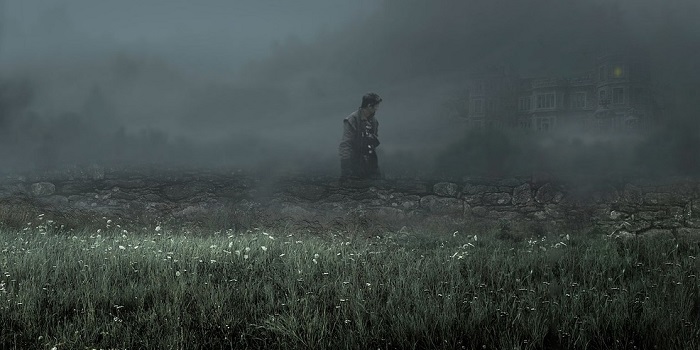
Several prominent novels from the 19th century revolved around a protagonist not associated with the positive traits of the traditional “hero” in literature, such as a high concept of morality, chivalry, responsibility and care; but rather, a protagonist who is, in fact, an “antihero,” one who leads himself and those surrounding him into pain and destruction. Such characters commonly consist of fundamental personality flaws, which drive both the character and the plot forward calamitously.
In the novels Wuthering Heights by Emily Brontë and Moby Dick by Herman Melville, there are such characteristic portrayals of two antiheroes: Heathcliff and Captain Ahab. This essay will discuss how those two characters exhibit symptoms of an antisocial personality disorder, which inflict an immense amount of suffering on other characters and which ultimately prompt them to their own demise.
Since both novels were published circa 1850, it is first important to stress that antisocial personality disorders were perceived much differently then than they are today. In fact, during that era, there was no such term as “antisocial personality disorder” at all, and people who exhibited symptoms of those kinds of disorders were mostly classified medically as insane or mentally ill.
For example, the pioneer French physician Philippe Pinel who documented the behavior and symptoms of his patients details the condition of violent patients with no regard or compassion toward others as “mania without delirium” or “mental derangement” (Pinel: 1806). Pinel proclaims that such “maniacs” often attempt to gratify their “most extravagant flights of fancy and caprice,” even in violent manners if necessary; yet, they are fully aware of their pernicious deeds, as they possess “sound reason” and “a perfectly sound judgement.”
Continuing the work of Pinel, J. C. Prichard further researched the behavior of homicidal criminals who did not exhibit mental faults with their intellect and termed their condition “moral insanity” (Prichard: 1835). Prichard infers that for people with this condition, “the moral and active principles of the mind are strangely perverted and depraved,”; but yet again, similar to Pinel’s conclusions, the patients do not display “discoverable illusion or hallucination.” Thus, at least since the beginning of the 19th century, there was some research and awareness of what we recognize today as an antisocial personality disorder, and it would have been accessible to Brontë and Melville, even though the study was in its early stages.
Considering that preliminary study of antisocial personality disorder did exist for almost half a century when Brontë and Melville wrote their novels and that it is plausible that they based at least some of the attributes of Heathcliff and Ahab on real-life figures, it would be fascinating to examine the protagonists’ characteristics and actions from modern lenses. A corroboration by contemporary tools would indicate that Brontë and Melville did aim to portray the protagonists who spread wreckage around them with what we identify today as an antisocial personality disorder.
In 1952, the American Psychiatric Association (APA) published the first edition of the Diagnostic and Statistical Manual of Mental Disorders (DSM), in which the APA attempted to create clear criteria for mental disorders. The publication included the criteria for “sociopathic personality disturbance,” which in 1968 would become “antisocial personality” in the second edition of the DSM; however, these editions gained a lot of notoriety for classifying homosexuality as a personality disorder until a revised edition of the DSM unlisted it in 1974. Over the years, the DSM has been further researched and refined by the APA, and the latest edition, the DSM-5, was published in 2013. This modern medical manual will be used to illustrate how Heathcliff and Ahab display the symptoms of antisocial personality disorder.
Identity and Self-Direction Impairments
The DSM-5 indicates that a person with an antisocial personality disorder will manifest impairments in self-functioning either by symptoms of his/her “identity” (A.1.a) or “self-direction” (A.1.b).
Heathcliff does partially evince identity impairments, especially ego-centrism; however, his self-direction impairments are much more evident and palpable. He clearly states on several occasions what his dire goal is, which is indeed based solely on personal sadistic gratification – to take revenge on his “enemies.” After he is forbidden to dine with everybody and embarrassed by Hindley and Edgar as a child, Heathcliff admits to Nelly that he is “trying to settle how [he] shall pay Hindley back,” no matter how long he has to wait; furthermore, he acknowledges that whilst he plans his revenge, he does not feel any pain (chapter VII).
Years later, he confesses to Catherine that he plans to marry Isabella simply to hurt others who are close to her because she treated him “infernally” when she married Edgar; he likens Catherine to a “tyrant” and himself to her “slaves” who cannot turn against her, so “they crush those beneath them,” aiming at Isabella (chapter XI). Only shortly before Heathcliff dies and after all the pain he inflicted on the habitants of Wuthering Heights and Thrushcross Grange, he intimates to Nelly that he “lost the faculty of enjoying their destruction” (chapter XXXIII). Throughout the narrative, Heathcliff does not even attempt to hide his “absence of prosocial internal standards” (DSM-5: A.1.b) as he abuses physically and emotionally almost anybody around him while he tries to fulfill his vengeful goals.
Like Heathcliff, Ahab also displays partial symptoms of identity impairments, particularly when he divulges to Starbuck his low self-esteem, which is derived from futile personal gain – the unfulfilled capture of Moby Dick – as he refers to his life at sea as “a forty years’ fool” (chapter 132). In another similarity to Heathcliff, Ahab’s self-direction impairments are also fully manifested in the novel; for him, his own personal vengeful gratification is also the only goal of the Pequod’s voyage, as he admits multiple times.
In his first speech in front of the entire Pequod crew, Ahab frenziedly incites them to hunt Moby Dick. He declares that the objective they are shipped for is “to chase that white whale on both sides of land, and over all sides of earth, till he spouts black blood and rolls fin out,” and then he makes them vow that God will hunt them “if [they] do not hunt Moby Dick to his death” (chapter 36). In the next scene, Ahab contemplates his madness when he is alone and prophesies to himself that he will “dismember my dismemberer” (chapter 37); this soliloquy demonstrates Ahab’s manic determination to obtain his personal goal at all costs, which ultimately this obsessive goal leads him and his entire crew to ruin.
Ahab’s absence of prosocial internal standards is revealed in times when the Pequod encounters other ships; Ishmael narrates that he does “not to consort … with any stranger captain, except he could contribute some of that information he so absorbingly sought” (chapter 53). For instance, when the captain of the Bachelor invites Ahab and his crew to celebrate their success with them, Ahab coarsely refuses once he realizes they have no information about Moby Dick while his crew remains “looking with grave, lingering glances towards the receding Bachelor” (chapter 115). In another encounter, Ahab callously declines to assist Rachel’s captain in locating his missing son because he is in a hurry to catch Moby Dick (chapter 128).

The impairments in self-functioning of Heathcliff and Ahab cause them to inexorably pursue their own personal goal at any cost, even at the expense of others, and sometimes – if it aligns with their personal goal – intentionally at the expense of others.
Empathy and Intimacy Impairments
The next criterion in the DSM-5 is impairments in interpersonal functioning, which is exhibited by either impairment related to empathy (A.2.a) or intimacy (A.2.b).
Heathcliff does not show too much empathy for the suffering of others, even if it is a direct result of his own wrongdoings; yet, his intimacy impairments are much more conspicuous. Heathcliff does not form any “mutually intimate relationship” (A.2.b) with anyone besides Catherine, and even this relationship knows several major crises from which they never fully recover their early connection. Moreover, it certainly appears that Heathcliff relates to others solely as a means to achieve his goals.
One of the most apparent instances of an exploitative relationship is his marriage to Isabella; he manipulates Isabella to believe that he genuinely wishes to marry her out of love just to make Catherine and Edgar suffer. A few weeks after their marriage, Heathcliff’s devious utilization of his new wife is fully unveiled when Isabella tells Nelly in a letter that Heathcliff mistreats her because he sees her as “Edgar’s proxy in suffering, till he could get hold of him” (chapter XIII).
In addition, Heathcliff also unscrupulously uses Hareton and his own sickly son, Linton, to take control over Thrushcross Grange by coercively marrying him to the also unwilling Cathy Linton. After numerous maneuvers of Heathcliff to bring Linton and Cathy closer together, Linton eventually breaks and admits to Cathy that his father makes him woo her and that if he fails, he “shall be killed” (chapter XXVII); thereafter, Heathcliff appears and persuades Cathy and Nelly to escort Linton back to Wuthering Heights, where he locks them up and keeps Hareton as a guard until Cathy relents and marries Linton.
Thus, Heathcliff uses dominance and intimidation to control and harm almost anybody around him, such as Isabella, Hareton, Linton, Nelly and Cathy.
In comparison, Ahab’s impairments in interpersonal functioning are almost equally parallel with those of Heathcliff: Ahab as well barely displays a modicum of empathy toward others, whilst his intimacy impairments are unmistakably perceptible. Ahab confesses to Starbuck that even in what is supposed to be his most intimate relationship – his marriage – he failed: he states that just a day after he married his wife, he “sailed for Cape Horn” and that he “widowed that poor girl when he married her” (chapter 132).
It seems that Ahab’s sole sympathetic relationship is with the deranged Pip, but not coincidentally, only after he goes insane: when Ahab hears Pip ramble crazily, he promptly declares that his “cabin shall be Pip’s home henceforth” and adds that Pip is “tied to me by cords woven of my heart-strings” (chapter 125). Thus, the only person with whom Ahab forms a close relationship is a demented person who cannot intelligibly communicate with anybody else.
Unlike Heathcliff, Ahab derives his authority over others from his official position as a captain; however, like Heathcliff, he also uses dominance and intimidation for control. Throughout the pages, Ahab frequently brandishes his command in a dictatorial manner. When the Pequod’s second mate, Stubb, politely asks Ahab to try to muffle the sound of his trampling because the sailors try to rest, Ahab first calls him a “dog,” then “a donkey, and a mule, and an ass” and then he advances toward him violently (chapter 29). Ahab also holds almost absolute control over everyday customs, such as dinners; Ismael notes that over his table, “Ahab presided like a mute, maned sea-lion” and that Ahab holds a “nameless invisible domineerings of the captain’s table” (chapter 34).
Thus, the impairments in interpersonal functioning of Heathcliff and Ahab are unmistakable, especially in regard to their incapacity to have a mutually intimate relationship with anybody else, which distances them from others and, therefore, perhaps makes it easier for Heathcliff and Ahab to cause harm.
Manipulativeness, Deceitfulness, Callousness, Hostility
The next criterion in the DSM-5 is “pathological personality traits” in the domain of “Antagonism,” characterized by manipulativeness (B.1.a), deceitfulness (B.1.b), callousness (B.1.c) and hostility (B.1.d).
Indeed, almost all of Heathcliff’s actions as an adult on his path to revenge are deeply infused with manipulations and deceit, as he is consistently hostile and callous to others whom he hurts. Heathcliff’s manipulative conduct begins to unfold almost immediately after he returns to Wuthering Heights from a few years of mysterious absence. He divulges to Catherine that Hindley “lost some money to him” playing cards, and consequently, Hindley invited him back to Wuthering Heights again (chapter X); later on, it turns out that Hindley already lost a significant sum to Heathcliff when Isabella retells in her letter that Hindley asked her, “Am I to lose all, without a chance of retrieval?” (chapter XIII). Heathcliff’s deceitful plan is fully uncovered after Hindley passes away: it is revealed that Hindley dies heavily indebted to Heathcliff due to his “mania for gaming,” and thus, Heathcliff “was now the master of Wuthering Heights” (chapter XVII). Heathcliff also takes over Thrushcross Grange by manipulations and deceit, as described previously.
From an early age, Heathcliff’s demeanor grows more and more callous and hostile toward the outer world, characterized by aggression, sadism and vengeful behavior. There is a clear indication of Heathcliff’s future callousness when Nelly narrates that as a kid, he never showed “any sign of gratitude” toward his adopted father and that “he was simply insensible” (chapter IV). There is also an early sign of Heathcliff’s unbridled mature hostility in Nelly’s remembrance of how due to his “violent nature,” Heathcliff “seized a tureen of hot apple sauce … and dashed it full against [Edgar’s] face and neck” after he believed that Edgar insulted him (chapter VII).
Heathcliff’s callousness and hostility culminate upon his return to Wuthering Heights after a few years of absence, and thereafter he begins to spread terror and sorrow everywhere around him; the incidents mentioned above of Heathcliff’s aggressive take over of both Wuthering Heights and Thrushcross Grange, his sadistic marriage to Isabella and his treatment of essentially any person in his way are all evident examples of those traits.
As Heathcliff, Ahab is deceitful and manipulative as well to influence the Pequod’s crew to align with his personal objective to pursue Moby Dick. During his frantically swaying speech, Ahab seductively presents a “Spanish ounce of gold” to the crew and states that whoever will spot a “white-headed whale with a wrinkled brow and a crooked jaw … shall have this gold ounce” (chapter 36) – a clear monetary incentive to the crew to stray away from their initial official objective. Ahab relates to his men as “tools” that he must use, but “men are most apt to get out of order”; he acknowledges that his magnetic influence on the crew can be temporal because sailors are “more or less capricious and unreliable” and therefore, they must pursue other whales they encounter on their way to Moby Dick (chapter 46).
Ahab does not only wields subterfuge by glibness but also in a much more practical sense. When the Pequod’s crew gets ready for its first whaling, a secret crew of “five dusky phantoms” suddenly surfaces on deck, being led by Ahab himself (chapter 47). Ishmael raises doubts about whether a captain should “jeopardize [his] life in the active perils of the chase,” especially when he is a “maimed man” such as Ahab; he determines that Ahab’s decision to lead a boat of five extra men “never entered the heads of the owners” and that Ahab did it “with a view to the ultimate chase of Moby Dick” (chapter 50).
Ahab is also quite hostile – especially when his authority is questioned – and callous as well, although those traits are not as conspicuous as in Heathcliff’s aggressive behavior. For instance, Ahab acts very hostilely toward Stubb when the latter dares to complain about the noise he makes with his prosthetic leg at night (chapter 29). A more extreme example of Ahab’s hostility occurs when Starbuck, the first mate, questions Ahab’s decision to let the oil casks leak; Ahab rages and “seize[s] a loaded musket from the rack … pointing it towards Starbuck” (chapter 109). In this event, Ahab also uncovers another layer of callousness toward the owners and their investment when he shouts at Starbuck to stop prating “about those miserly owners, as if the owners were [his] conscience.” It is important to note that besides Captain Bildad and Captain Peleg – who are the “largest owners of the vessel” – there are also “widows, fatherless children, and chancery wards” who depend on the income of the Pequod (chapter 16).
Hence, these specific pathological personality traits directly afflict others, who are sometimes only remotely connected to Heathcliff and Ahab.
Irresponsibility, Impulsivity, Risk-Taking
The second part of pathological personality traits in the DSM-5 relates to disinhibition, characterized by irresponsibility (B.2.a), impulsivity (B.2.b) and risk-taking (B.2.c).
Heathcliff exhibits utter irresponsibility – or “disregard for obligations or commitments” (B.2.a) – with his uncommitted marriage to Isabella, whom he abuses and never actually intends to treat as his wife. Heathcliff does not only disregard his responsibility as a husband but, even more neglectfully, as a father; his relationship with his son Linton is completely dysfunctional, and he is not at all responsible or paternal as a parent should be. Although Heathcliff knows that his unhealthy son is in London, he does not attempt to claim any responsibility for Linton during the first twelve years of his life, and the only time he relates to him during this period, he tells Nelly, “I’ll have it … when I want it” (emphasis added, chapter XVII). Only after Isabella dies and Edgar takes Linton to Thrushcross Grange does Heathcliff send Joseph to take Linton to Wuthering Heights (chapter XIX); yet, Heathcliff refers to him as his “property” and blatantly admits to Nelly that he “should not wish him to die till [Heathcliff] was certain of being his successor” (chapter XX).
Heathcliff presents signs of impulsivity, especially at a younger age, and particularly in the form of storming out indignantly after being slighted by Catherine. When young Heathcliff meets Catherine again after she sojourned five weeks at Thrushcross Grange, she insults him by calling him “dirty”; consequently, Heathcliff seethes and proclaims that he likes to be dirty and “dashe[s] headforemost out of the room” (chapter VII). Shortly after, he throws “a tureen of hot apple sauce” at Edgar in an additional impulsive act. In another impulsive withdrawal, Heathcliff leaves the room after Catherine offends him again, this time by implying that he “know[s] nothing and say[s] nothing” (chapter VIII). The most meaningful time that Heathcliff impulsively storms out is when he eavesdrops on a conversation between Catherine and Nelly in which Catherine discloses, “It would degrade me to marry Heathcliff” (chapter IX). Heathcliff immediately withdraws after hearing it and does not remain to hear how Catherine confesses how much she loves him.
Heathcliff’s risk-taking inclinations are distinct in his chancy – and ultimately successful – plots to own Wuthering Heights and Thrushcross Grange as already described. He knowingly jeopardizes both his wealth and his life when he lends money to Hindley; he consciously endangers the health of his ailing son Linton when he pushes him to meet Cathy Linton several times; and he risks getting in trouble with the law when he locks up Cathy and Nelly.
As Heathcliff with his marriage, Ahab also shows “disregard for obligations or commitments” in a different sort of contract – with the crew, owners and the annuitants of the Pequod. Instead of maximum profits by whaling – the original objective of the ship – Ahab’s sole objective is to find and hunt Moby Dick. This utter disregard for his contract not only costs the lives of almost the entire Pequod’s crew, including Ahab’s, but also the loss of investment of the owners, who include “widows” and “fatherless children” among others (chapter 16). Thus, Ahab knowingly and negligently rejects his financial responsibilities just to satisfy his own thirst for vendetta.
Ahab’s impulsivity is often coupled with hostility, which was mentioned before. In impulsive violent acts, he almost attacks Stubb, who merely asks him politely to try to be quieter at night (chapter 29), and points “a loaded musket” at Starbuck, who raises doubts about a decision he makes (chapter 109). Ahab’s risk-taking is strikingly marked in his active participation in whaling and in his dangerously relentless obstinacy to pursue Moby Dick. Ahab is determined to partake in the hunting personally, even though it is debatable whether or not a captain should be directly engaged in this activity, and it is even more controversial when the captain hobbles only on one leg. For this unusual dubious purpose, Ahab recruits a secret crew, which he leads by himself, and thus, as Ishmael comments, he “reveal[s] his intention to hunt that mortal monster in person” (chapter 50).
Ahab’s implacable propensity towards risk-taking culminates at the end of the narrative when he faces Moby Dick in several deadly encounters, during which he ignores his severe losses and warnings until the Pequod’s final calamitous end. In the first encounter, Moby Dick wrecks Ahab’s boat with his jaws that “bit the craft completely in twain”; in the aftermath, Starbuck hints that perhaps this was “an omen, and an ill one,” but Ahab only repudiates him bluntly (chapter 133). The second encounter turns out to be even worse as Moby Dick dashes the boats of Stubb and Flask “together like two rolling husks on a surf-beaten beach,” thereafter sends Ahab’s boat “gunwale downwards” and ultimately drags Fedallah into the depths; again, Starbuck warns Ahab that he “never, never wilt … capture him,” and again, Ahab dismisses him (chapter 134). In the third and last encounter, Moby Dick sinks the Pequod upon all its crew as “the solid white buttress of his forehead smites the ship’s starboard bow” and drowns Ahab after his rope “caught him round the neck” (chapter 135).
These pathological personality traits, and especially risk-taking, are the causes for the most damaging deeds of Heathcliff and Ahab, which allow the protagonists to push their own personal boundaries forward on the expanse of the lives of others and, in Ahab’s case, also his own.
Criteria C, D, E and F in the DSM-5 are simple yes or no clauses and are all positively pertinent to Heathcliff and Ahab, as illustrated. To both, the impairments in personality functioning are “relatively stable” and “consistent” (C); they are not related to their “developmental stage or sociocultural environment” (D); they are not a result of “physiological effects of a substance … or a general medical condition” (E); both characters are at least 18 years old (F).
To Conclude
As analyzed and depicted, Brontë and Melville brilliantly portray two complex antiheroes who display all the symptoms of antisocial personality disorder according to modern criteria, although the authors did not possess the contemporary medical information we have today. This could be explained by the authors’ astute perception and artful imitation of real behaviors through the fictional characters, which accurately corroborate the current DSM-5 standards. In addition to the highly convincing mental characterization – and often realistically disturbing – of Heathcliff and Ahab, Brontë and Melville set the antiheroes to leave a trail of wreckage all around them as a direct result of their impaired psychological traits. Wuthering Heights and Moby Dick highlight the destructive potential that one extremely resourceful and mentally disturbed individual can have on his contiguous surroundings and, ultimately, on himself.
After reading the novels, the readers can better discern detrimental behavioral attributes associated with antisocial personality disorder and perhaps be more vigilant not to be dragged down with the bearers of such attributes into the depths.
Works Cited:
American Psychiatric Association. 2013. Diagnostic and Statistical Manual of Mental Disorders (DSM-5®). American Psychiatric Pub.
Pinel, P. 1806. A Treatise on Insanity: In which are Contained the Principles of a New and More Practical Nosology of Maniacal Disorders Than Has Yet Been Offered to the Public (Vol. 1806). W. Todd.
Prichard, J. C. 1835. A Treatise on Moral Insanity and other Diseases Affecting the Mind. London: Sherwood, Gilbert and Piper.



